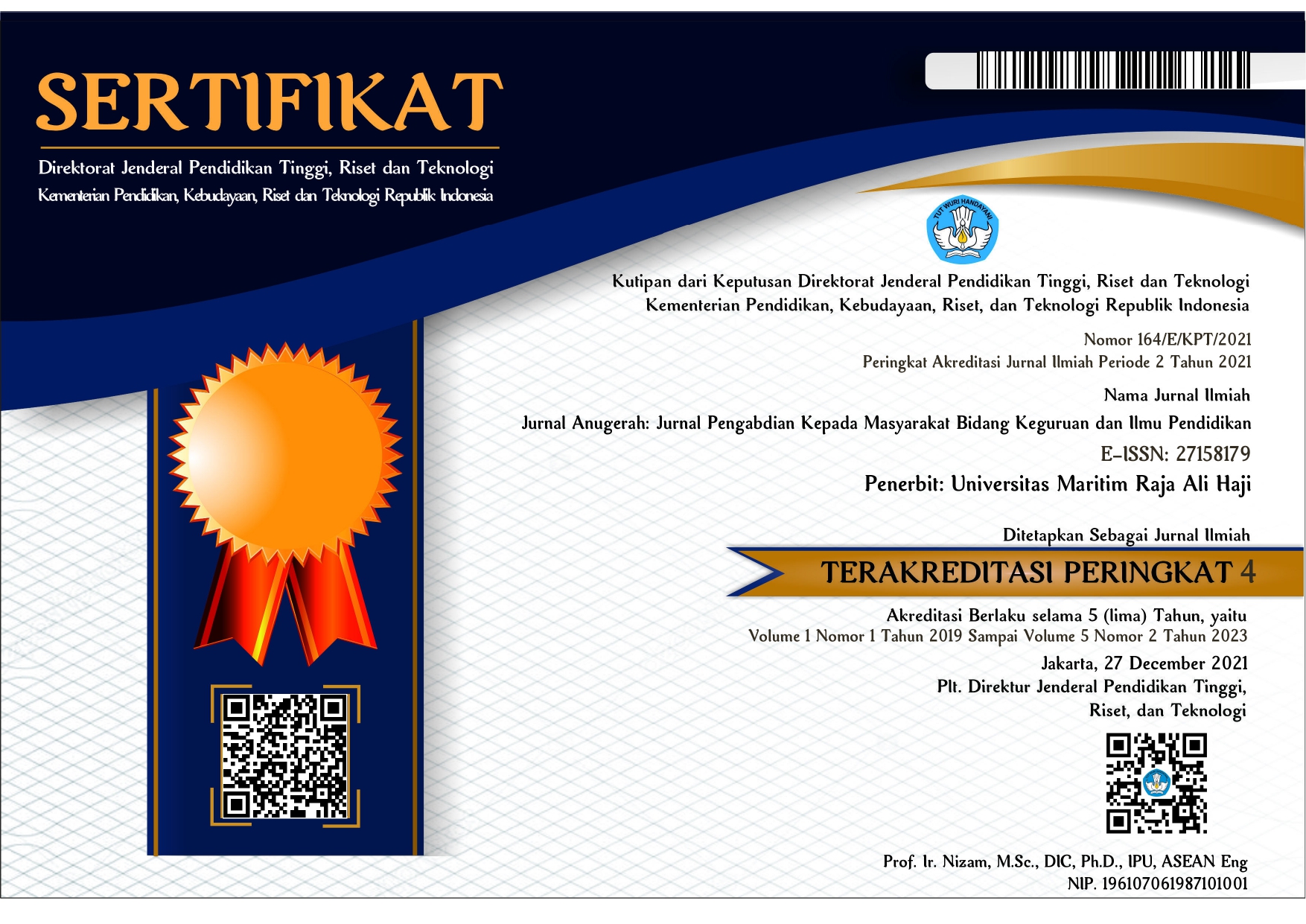Pentingnya Stepping the 5 Stairs “A†Teknik Untuk Anak-Anak Pesisir yang Belajar Grammar
DOI:
https://doi.org/10.31629/anugerah.v1i1.1610Keywords:
stepping the 5 stairs , grammar, coastal learnersAbstract
The English learning experience especially Grammar should be done in a fun way and make the language learners master the concept well. The importance of mastering Grammar well facilitates language learners to construct English sentences from various tenses. Coastal language learners have not been given good grammar understanding and do not have enough time to learn grammar in schools. To master Grammar, Stepping the 5 Stairs "A" technique offers fun grammar learning. There are already many techniques offered. However, the existing techniques do not accommodate the characteristics of the language learning methods of those from certain regions. The descriptive approach is a method of implementing community service. The team conducted a site survey and interviews with several residents’ representatives and coastal learners’ parents. The community service location is in Senggarang Village where foreign tourists pay a visit. The results of the community service are: (1) An increase in the knowledge and understanding of coastal learners about Grammar learning by using the Stepping the 5 Stairs "A" technique, (2) Coastal learners’the motivation to continue learning Grammar, and (3) There are requests from coastal learners, parents, RT, RW, and Karang Taruna Senggarang to the team to continue similar activities going forward
References
Agust, S. (2017). Mastering the advanced grammar by stepping the 5 stairs up. Tanjungpinang: UMRAH PRESS.
Agust, S. (2019). Let’s step the stairs to learn grammar. Tanjungpinang: UMRAH PRESS.
Al-Mekhlafi, A. M., & Nagaratnam, R. P. (2011). Difficulties in teaching and learning grammar in an EFL context. International Journal of Instruction, 69-92.
Andy, R., & Muzammil, L. (2018). Pelatihan berbahasa Inggris dengan drilling dan repetition bagi Karang Taruna Desa Jedong. MARTABE: Jurnal Pengabdian Masyarakat, 42-48.
Conrad, S. (2000). Will corpus linguistics revolutionize grammar teaching in the 21st century? TESOL Quarterly, 548–559.
Ellis, N. C. (2005). How explicit knowledge affects implicit language learning. Studies in Second Language Learning, 305-352.
Ellis, R. (1995). Interpretation tasks for grammar teaching. TESOL Quarterly, 87–105.
Ellis, R. (2001). Investigating form-focused instruction. In R. Ellis (Ed.), Form-focused instruction and second language learning. Malden, MA: Blackwell.
Ellis, R. (2002). Does form-focused instruction affect the acquisition of implicit knowledge? A review of the research. Studies in Second Language Acquisition, 223-236.
Hahn, A. (2000). Grammar at its best: The development of a rule- and corpus-based grammar of English tenses. In L. Bernard & T. McEnery (Eds.), Rethinking language pedagogy from a corpusbased perspective. Bern: Peter Lang.
Harley, B., & Swain, M. (1984). The interlanguage of immersion students and its implications for second language teaching. Interlanguage, 291-311.
Hasanah, H. U. (2016). Respon mahasiswa terhadap pembelajaran grammar berbasis website. Nuansa, 50-74.
Hinkel, E., & Fotos, S. (2002). New perspectives on grammar teaching in second language classrooms. Mahwah, NJ: Erlbaum.
Hughes, R., & McCarthy, M. (1998). From sentence to discourse: Discourse grammar and English language teaching. TESOL Quarterly, 263–287.
Lightbown, P. M. (1990). Focus-on-form and corrective feedback in communicative: Effects on second language learning. Studies in Second Language Acquisition, 429-448.
Lightbown, P. M. (2008). Transfer appropriate processing as a model for class second language acquisition. Understanding second language process, 27-44.
Liu, D., & Master, P. (2003). Grammar teaching in teacher education. Alexandria, VA: TESOL.
Navaz, A., & Sama, F. (2017). Teaching grammar in the English language classroom: Perceptions and practices of students and teachers in the Ampara District. Proceedings of 7th International Symposium, 653-667.
Philp, J. (2003). Constraints on “noticing the gapâ€: Nonnative speakers’ noticing of recasts in NS–NNS interaction. Studies in Second Language Acquisition, 99-126.
Ragan, T., Boyce, M., Redwine, D., Savenye, W., & C., M. J. (1993). Is multimedia worth it? Association for Educational Communications and Technology Convention. New Orleans.
Risnawaty. (2018). Pelatihan Bahasa Inggris melalui media gambar dengan Direct Method (Metode Langsung). Prosiding Seminar Nasional Hasil Pengabdian, 323-327.
Setyowati, L., & Muthoharoh, N. B. (2018). Penggunaan self-study book terhadap guru-guru Sakinah English Course. E-DIMAS: Jurnal Pengabdian kepada Masyarakat, 70-76.
Widyastuti, M., & Kusumadewi, H. (2018). Penggunaan aplikasi Duolingo Dalam meningkatkan kamampuan kosakata Bahasa Inggris pada tenaga pengajar bimbingan belajar Omega Sains Institut. Jurnal Abdimas BSI, 237-244.
Yuan, F., & Ellis, R. (2003). The effects of pre-task planning and on-line planning on fluency, and accuracy in L2 oral production. Applied Linguistics, 1-27.















